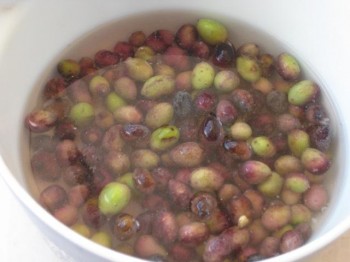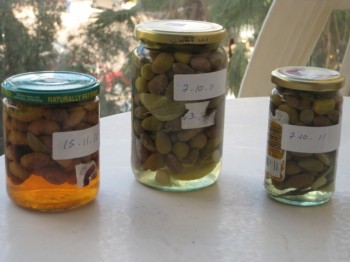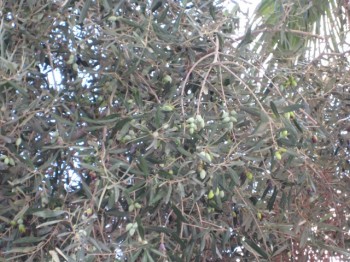 Call me Olivias de Maurico: This Syrian olive tree is loaded with fruit, most of which will fall to the ground, unpicked.
Call me Olivias de Maurico: This Syrian olive tree is loaded with fruit, most of which will fall to the ground, unpicked.
The autumn olive harvest is still in full swing, and those of you who are now enjoying picking and preserving this ancient Middle Eastern fruit are surely aware that this year’s crop is much better than the poorer crop years of the past years when olive crops in both Israel and the Palestinian areas were much less. I have been engaged for several years now in an “urban harvest” where people grow and harvest their own fruit and veggies in the middle of populated urban areas. Here’s how I do it.
Many people living in Israel and Palestine are lucky enough to have olive trees growing in their own neighborhoods or even their own backyards.
My apartment project has a number of olive trees planted in our building garden, as well as in nearby parks. Most of the fruit from these trees are either the narrow and pointed Syrian olives or the round Mission and Manzanillo olives which are both good for either pickling or oil.
I pick them both and afterwards pickle them, using a recipe that I fondly refer to as ” Olivias de Mauricio”.
Picking one’s own fruit is a very important part of this endeavor, and I recommend doing this as otherwise, most of the fruit on these “park trees” wind up falling to the ground or sidewalk as the case may be.
My pickling method for green olives is very simple. After picking, sorting, and washing the fruit (try not to mix varieties, if possible) soak the olives in clean water for 10 – 12 days, changing the water daily. I recommend using either water from an under the sink filtration unit or a Brita water filter, to rid the water of chlorine and minerals which can affect the taste of the olives. These nasty chemicals can also affect our health.
The fruit is ready to be put in jars for picking when it changes color and begins to have an “olive” color and odor to them. The water soaking process takes a lot of the bitterness out of the fruit.
 Soaking olives: change water daily
Soaking olives: change water daily
For the pickling process use clean jars in good condition and with lids that are not rusty. Cleaning the jars with hot soapy water and then rinsing in hot water is recommended as well.
When pickling, I make a brine consisting of water, rock salt, vinegar, and taste conducive ingredients like lemon slices, clean olive leaves, and pieces of fresh garlic.
There’s no set formula for the “spices” as it depends on whether one wants “garlicky” olives or those with more of a lemon taste. You can also add some cut chili peppers for a bit of a “kick”, if desired.
The brine has to contain at least 10 percent salt and an equivalent amount of 5% acidic vinegar (the citrus type is best) for the pickling to be successful.
 Processed olives: jar on left has been curing almost a year.
Processed olives: jar on left has been curing almost a year.
The actual pickling process simply involves putting layers of fruit, lemon slices, olive leaves and garlic chunks or slices until they fill the jar almost to the top.
Then pour in the brine mixture until it reaches just under the top of the jar (about 1/4 inch or 5 cm). Before closing the jar lid, pour enough good quality olive oil in to cover the entire top of the brine mixture.
This keeps mold from forming during the pickling process. After tightly closing the jar and checking for leakage (turn jar upside down to do this) wipe the outside of jar to clean off any picking residue and then label the jar with the date that the picking process was done – this makes it easier to know how long the ingredients have been “working”.
Store the jars in a place away from sunlight (like in a kitchen cupboard) for a minimum of 2-3 months before using.
Ripe olives will cure faster, so bear this in mind if picking ripe or nearly ripe olives.
After opening a cured fruit jar, store it in your refrigerator. Remember that the longer the curing or picking process is allowed to work, the better the olives will taste. And best of all, you have the enjoyment eating olives you picked and pickled yourself.
Enjoy!
Read more on olives and other Mid East seasonal fruit:
Picking Olives for Pickling
Aphrodisiacs of the Middle East: Pomegranate
Olives, Dates and October Seasonal Produce in the Middle East





Mine’s started the fermentation process and I had to throw them away.
How did it start?